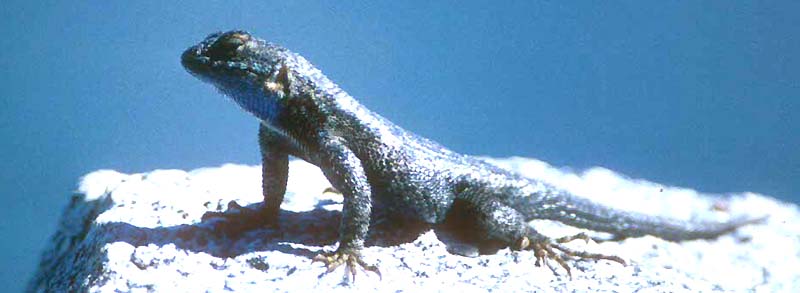

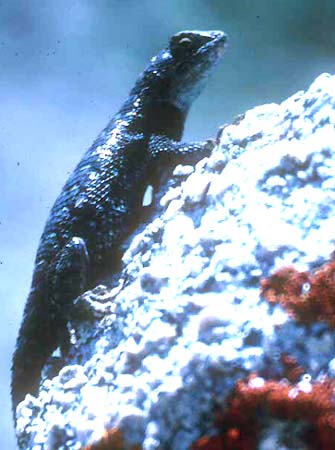 |
This discussion of California's small scaly lizards begins with the
common "blue-bellies" in the genus
Sceloporus, and particularly
the widespread
Western Fence Lizard S. occidentalis (above,
left and below). Males (above & left) have blue bellies (and often
blue throats) and can be speckled with blue above. Females can have blue
bellies but many females and youngsters (below) do not. Their upperpart
color varies from quite dark (above & left) to a camouflage pattern
of brown and cream blotches (below).
|
|
For what it's worth, the photos here show three widely separated populations: the top photo was taken at high elevation in Sequoia Nat'l Park, Tulare Co., and thus is apparently S. o. taylori, the Sierra Fence Lizard. This is the largest subspecies with males reaching over 8 inches. The dark-backed lizard above left (on the rock with orange patches) is from extreme southeast Mono County and would be among the Great Basin populations under the old terminology. The more patterned youngster (above right) and the male (below two photos) are from the coastal populations in Monterey County. |
| I once witnessed a very unexpected and impressive display in a Western
Fence Lizard at Andrew Molera State Park, Monterey County (two right
shots). The blue-bellied but white-throated male began a series of push-ups,
and at the height of each he flared out his vivid blue belly and extended
his gular flap. While I often see males doing "push-ups," I've never seen
the gular flap display before or since.
Note how "scaly" all the various Western Fence Lizards appear. They look "rough" from above. The Stebbins' guides (1966, 1985, 2003) all emphasize the yellow or orange color on the back of the legs, but I find this feature very hard to see. Western Fence Lizards eat mostly insects and spiders. They lay clutches of 3-17 eggs (sometimes multiple broods) between April and July. |
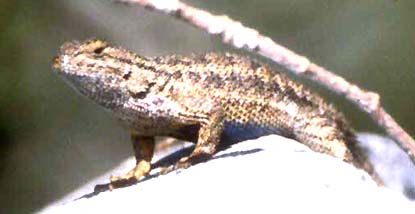
 |
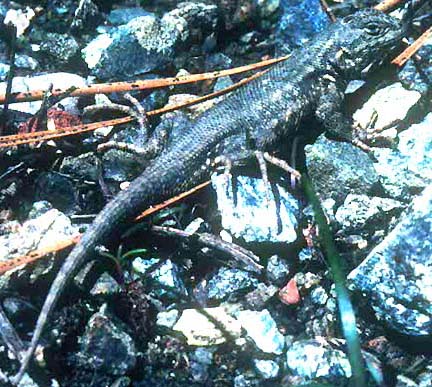 |
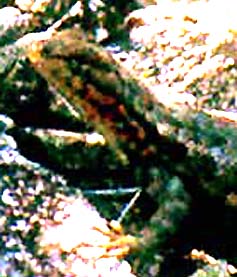 A
closely related Sceloporus is Common Sagebrush Lizard S.
graciosus (left & right). It has three subspecies [Western, Northern,
Southern) but both of those shown here are from the Western, nominate group.
This lizard overlaps with Western Fence Lizard in places but generally
occurs at higher elevations. Indeed, both of these photos are about as
high as one can go in Humboldt Co. (left; Horse Mt.) and Monterey Co. (right;
Cone Peak]. A
closely related Sceloporus is Common Sagebrush Lizard S.
graciosus (left & right). It has three subspecies [Western, Northern,
Southern) but both of those shown here are from the Western, nominate group.
This lizard overlaps with Western Fence Lizard in places but generally
occurs at higher elevations. Indeed, both of these photos are about as
high as one can go in Humboldt Co. (left; Horse Mt.) and Monterey Co. (right;
Cone Peak].
Identification can be complicated but in the height of the breeding season (June-Aug) many Sagebrush Lizards have orange washes to the throat or body (above right). At all times they look less "rough" than Fence Lizards, they generally lack the yellow or orange on back of limbs, and they often have black bar at the shoulder. |
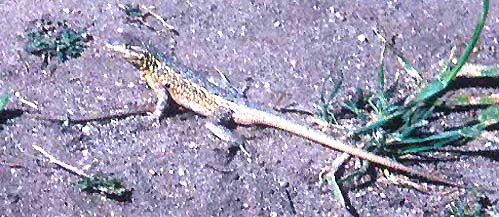 The
final of the trio of widespread, small, scaly lizards is Side-blotched
Lizard Uta stansburiana (right). In California it is often the
commonest small lizard in the deserts, but its range also extends in arid
habits up the coast ranges to central California. In the south it is active
all year among rock, sand, or hardpan with small scattered bushes. It is
not nearly as "scaly" as the other two widespread species; they are, of
course, Sceloporus while Side-blotched is in the genus Uta.
The scales are small and smooth, giving the lizard a "smooth" rather than
"rough" appearance. Most individuals have a more-or-less conspicuous black
blotch on each side of the chest, behind the forelimb. It can look "stripy"
somewhat, and is often washed with a bit or pale orange along the sides.
Ground color varies widely with its habitat — it can be blotched or speckled
(like the one here, taken in the Carrizo Plain, San Luis Obispo Co.) or
unpatterned. Stebbins (1985, 2003) lists no subspecies at all, but Crother
et al. (2001) lists four [Western, Nevada, Northern, Eastern]. Side-blotched
Lizards are not necessarily the closest relatives to Sceloporus,
but I include them together with Fence and Sagebrush lizards because I
have trouble with these small lizards. The
final of the trio of widespread, small, scaly lizards is Side-blotched
Lizard Uta stansburiana (right). In California it is often the
commonest small lizard in the deserts, but its range also extends in arid
habits up the coast ranges to central California. In the south it is active
all year among rock, sand, or hardpan with small scattered bushes. It is
not nearly as "scaly" as the other two widespread species; they are, of
course, Sceloporus while Side-blotched is in the genus Uta.
The scales are small and smooth, giving the lizard a "smooth" rather than
"rough" appearance. Most individuals have a more-or-less conspicuous black
blotch on each side of the chest, behind the forelimb. It can look "stripy"
somewhat, and is often washed with a bit or pale orange along the sides.
Ground color varies widely with its habitat — it can be blotched or speckled
(like the one here, taken in the Carrizo Plain, San Luis Obispo Co.) or
unpatterned. Stebbins (1985, 2003) lists no subspecies at all, but Crother
et al. (2001) lists four [Western, Nevada, Northern, Eastern]. Side-blotched
Lizards are not necessarily the closest relatives to Sceloporus,
but I include them together with Fence and Sagebrush lizards because I
have trouble with these small lizards.
Side-blotched Lizards in the Colorado and Mojave deserts may lay up to 8 clutches of 5-6 eggs each between Feb-June each year. This is just one reason these lizards are often abundant. They are also an important prey item for other predators, and this helps keep their overall numbers in check (Sanborn 1994). |
In the three photos below, I compare these three small lizards side-by-side, choosing those photos in my collection with patterns and poses most similar to each other:
 |
Monterey Co. |
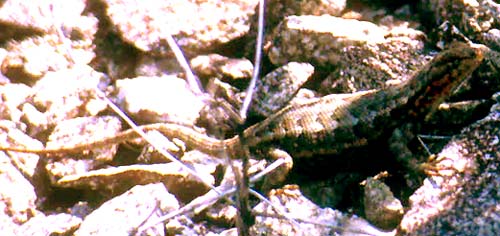 |
Monterey Co. |
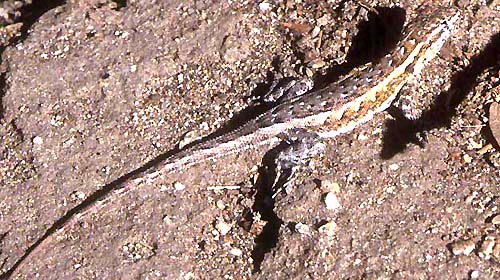 |
San Diego Co. |
There are many on-line resources for lizards. My favorites are:
Literature cited:
Crother, B.I., chair. 2001. Scientific and standard English names of amphibians and reptiles of North America north of Mexico, with comments regarding confidence in our understanding. Committee of Standard English and Scientific Names, Society for the Study of Amphibians and Reptiles, Herpetological Circular 29 (as supplemented in Herp. Review 32: 152-153).PHOTOS: All photos © 2003 Don Roberson, all rights reserved. These are the specifics:Sanborn, S.R. 1994. The Lizard-Watching Guide. Lorraine Press, Salt Lake City, UT.
Stebbins, R.C. 1966. A Field Guide to Western Reptiles and Amphibians. Houghton Mifflin, Boston.
Stebbins, R.C. 1985. A Field Guide to Western Reptiles and Amphibians. 2d ed. Houghton Mifflin, Boston.
Stebbins, R.C. 2003. A Field Guide to Western Reptiles and Amphibians. 3d ed. Houghton Mifflin, Boston.